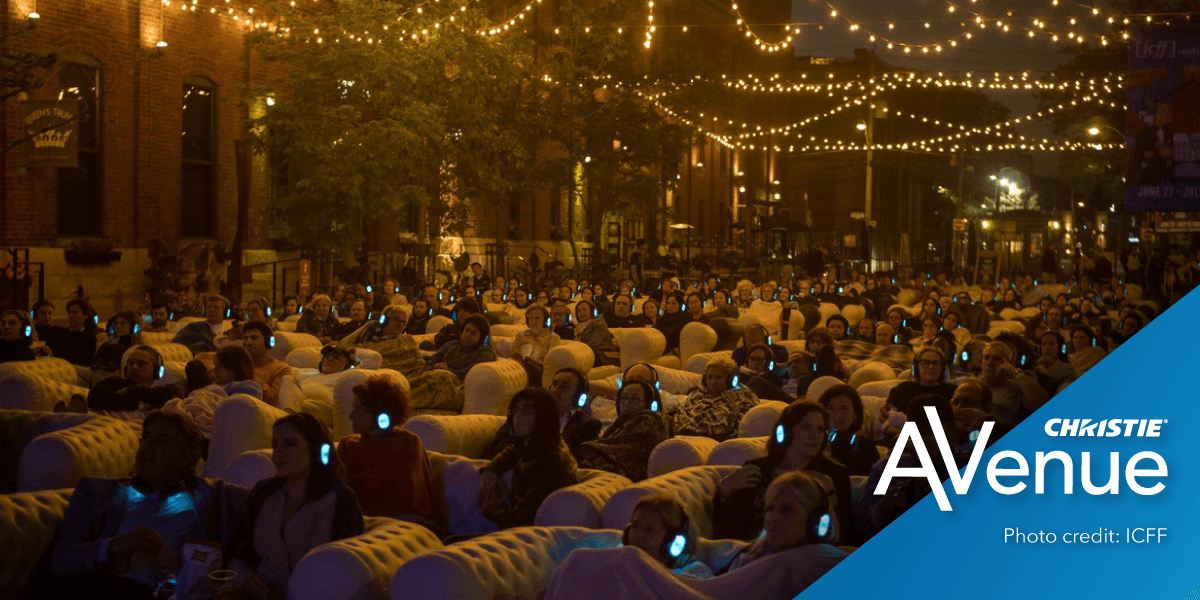Sofas in the streets. Screens in the city.

It should never have worked. You can’t put an outdoor cinema on a busy street. People live there among the shops and cafes and nightlife. There are passersby too — and how do you check tickets and stop people watching for free? Surely it can’t be done.
Well, yes, it can, as ICFF has rather delightfully proven at the Lavazza IncluCity Festival, Toronto. They’ve built an open-air cinema in the heart of the Distillery District’s pedestrianized streetscape for two years now. It brings cinema, complete with world-class projection and sound, right into the middle of a commercially active and constantly busy community. It’s madness, but it works.
Dog walkers and distractions
In the time of shut-downs during the pandemic, Cristiano De Florentiis, ICFF’s co-founder and creative director, had a problem. He still wanted to run his highly successful film festival, but outdoors. Conventional thinking meant a park, but a park meant dog walkers, distractions, and audiences perched on uncomfortable plastic seating for hours. Which wasn’t what he wanted at all. He wanted the comfort of a cinema in an outdoor urban space and was certain that’s what his audiences wanted too.
Cristiano came up with a three-part solution. Two were predictable: world-class projection courtesy of Christie and Sound Off noise-canceling wireless headphones. The third was less so: eighty-five comfy, inflatable sofas complete with side tables.
Not only did the headphones mean that if you didn’t buy a ticket, you couldn’t hear the movie, they also meant that life on the street could carry on. Conversations in cafes could still happen and residents in the condos above wouldn’t hear movie soundtracks as they drifted off to sleep. All while — mere meters away — the audience could enjoy a proper, immersive cinema experience.
The projection, of course, came from Christie®, long-term sponsors of what is, in effect, their local film festival. A Christie 4K DCI-compliant cinema projector was more than capable of bringing a cinema experience to the streets without compromise. There was, however, one small problem: an old Victorian iron bridge crossed the street. Pretty, but right in the projection path. So Christie engineers devised a cunning plan of mirrors and lenses that allowed the projector to be mounted at right angles to the screen on a short throw. Everyone was happy.
More than just a comfy place to sit
And then there were the sofas. They’ve become the abiding image of ICFF, but it turns out they were far more than just a comfy place to sit. Cristiano says one of his biggest challenges was reassuring the streetside cafes, bars, and restaurants that business would be unaffected while his movies were showing. They, after all, were paying rent, and he wasn’t.
Super happy
Cristiano explains how the sofas made it work. “Everybody loves to eat and drink while they’re watching a movie. It’s natural. So all we had to do was make sure the audience purchased from the outlets that were already there, and that was easy when everyone sitting on sofas were ready-made customers waiting to be served. Coffee, cake, three-course meal — whatever they wanted. And when there was an international movie, we kept the theme. For a Japanese night, there was sushi and sake and traditional Japanese music. What’s more, we found that people came to watch the people watching the movie — and they got hungry too. The place was hugely popular and local businesses were super busy. People were spending hours there.”
ICFF had not only shown that street and screen could co-exist but would naturally prosper in each other’s company. An existing outdoor gathering space had been enhanced by cinema and made magical, wonderful and memorable.






